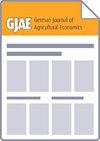A Meta-Analysis of the Price and Income Elasticities of Food Demand
IF 1.5
4区 经济学
Q4 AGRICULTURAL ECONOMICS & POLICY
引用次数: 21
Abstract
Food demand elasticities are crucial parameters in the calibration of simulation models used to assess the impacts of political reforms or to analyse long-term projections, notably in agricultural sectors. Numerous estimates of these parameters are now available in the economic literature. The main objectives of this work are twofold: we seek first to identify general patterns characterizing the demand elasticities of food products and second to identify the main sources of heterogeneity between the elasticity estimates available in the literature. To achieve these objectives, we conduct a broad literature review of food demand elasticity estimates and perform a meta-regression analysis. Our results reveal the important impacts of income levels on income and price elasticities both at the country (gross domestic product-GDP) and household levels: the higher the income is, the lower the level of elasticities. Food demand responses to changes in income and prices appear to follow different patterns depending on the global regions involved apart from any income level consideration. From a methodological viewpoint, the functional forms used to represent food demand are found to significantly affect elasticity estimates. This result sheds light on the importance of the specification of demand functions, and particularly of their flexibility, in simulation models.粮食需求价格与收入弹性的元分析
粮食需求弹性是校准用于评估政治改革影响或分析长期预测(特别是在农业部门)的模拟模型的关键参数。现在在经济学文献中可以找到许多对这些参数的估计。这项工作的主要目标有两个:我们首先寻求确定表征食品需求弹性的一般模式,其次确定文献中可用的弹性估计之间异质性的主要来源。为了实现这些目标,我们对粮食需求弹性估计进行了广泛的文献回顾,并进行了元回归分析。我们的研究结果揭示了收入水平对国家(国内生产总值- gdp)和家庭层面的收入和价格弹性的重要影响:收入越高,弹性水平越低。粮食需求对收入和价格变化的反应似乎遵循不同的模式,这取决于所涉及的全球区域,不考虑任何收入水平的因素。从方法学的角度来看,用于表示粮食需求的函数形式被发现显著影响弹性估计。这个结果揭示了需求函数规范的重要性,特别是它们的灵活性,在模拟模型中。
本文章由计算机程序翻译,如有差异,请以英文原文为准。
求助全文
约1分钟内获得全文
求助全文
来源期刊

German Journal of Agricultural Economics
AGRICULTURAL ECONOMICS & POLICY-
CiteScore
1.60
自引率
20.00%
发文量
0
期刊介绍:
The GJAE publishes a broad range of theoretical, applied and policy-related articles. It aims for a balanced coverage of economic issues within agricultural and food production, demand and trade, rural development, and sustainable and efficient resource use as well as specific German or European issues. The GJAE also welcomes review articles.
 求助内容:
求助内容: 应助结果提醒方式:
应助结果提醒方式:


